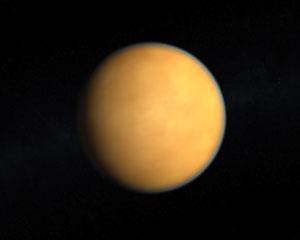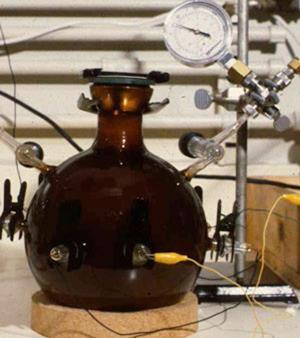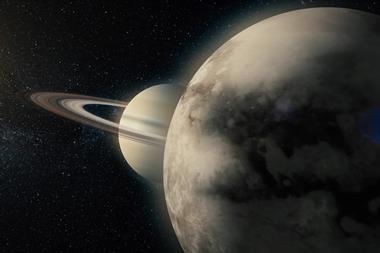Organics dissolved in Titan’s lakes may create conditions suitable for life

Scientists should expand their quest for life in other worlds by searching for any kind of liquid, not just water, say researchers. Rich organic chemistry can occur in many types of liquid, and a recent study supports the idea that a prebiotic ‘soup,’ from which life could emerge, may be present in hydrocarbon lakes of Saturn’s largest moon, Titan.
‘We think that life requires liquid,’ says Chris McKay from Nasa, who led the study. ‘Right now, there’s a bias that that liquid has to be water. But maybe when we look at other moons and planets, we should be asking what other possible liquids there could be.’
Using new data from the Cassini probe, which has been orbiting Titan since 2004, alongside his team’s lab research, McKay has released the first year results of a five-year investigation into whether a prebiotic soup could form on Titan.
Titan has rich organic chemistry in its atmosphere. The precise nature of the aerosols is unknown, but the researchers believe them to be complex organic macromolecules, so-called polyaromatic hydrocarbons (PAHs). Photochemical reactions involving methane and nitrogen produce a range of gaseous organics and solid organic haze, called tholin. This haze eventually falls down onto the surface and into Titan’s lakes, believed to consist of a mixture of methane and ethane. ‘We know there is liquid on the surface, we know there are solid organics falling from the sky. So we tested to see if any of the solid organics would go into solution,’ says McKay. A solution would result in a prebiotic soup that is a necessary condition for life.
Prebiotic soup

To test whether such a soup could exist, McKay and colleagues had to simulate the aerosols in Titan’s atmosphere. They created a gas mixture of 90% nitrogen and 10% methane, and then irradiated it with a continuous electrical discharge for several weeks, to simulate sunlight.
The resulting product was a brown organic material, consisting of carbon, hydrogen and nitrogen - a lab-made analogue of tholin. Its optical properties fit the broad wavelength dependence of Titan’s reflectance of sunlight, confirmed by data from orbiters.
The team then tested whether the lab-made tholin would be soluble in the kind of hydrocarbons that fill Titan’s lakes. They mixed several hundred milligrams of tholin with 100 ml of isopentane – a hydrocarbon from the same family as methane and ethane that is liquid at room temperature. Once tholin dissolved, the researchers cooled the mixture by diluting it with liquid ethane.
‘When this mixture was cooled, some of the tholin constituents remained in solution,’ says another team member, Malika Carter of Nasa. These constituents – nitriles, dinitriles and other nitrogen-containing molecules – were detected using gas chromatography-mass spectrometry (GC-MS).
This means that solid organics from the atmosphere do get into solution on the surface, and indicates that it should be possible for the pre-conditions for life to emerge.
Frigid temperatures
This is the first time soluble tholin constituents in liquid ethane have been reported. ‘The temperature at which our research was conducted was much lower than the temperatures reported in findings by other researchers,’ says Carter. ‘We were able to develop a method to dissolve tholin in liquid ethane (through cold isopentane) at a temperature close to that of Titan’s surface.’
Daniel Cordier of the Astronomical Observatory in Besançon, France, who was not involved in the study, calls the findings important. ‘Up to now, tholins have been considered to have a very low solubility in solvent like liquid ethane, but in this work we have a [much higher] value,’ he says.
But Catherine Neish of the Florida Institute of Technology cautions that tholin’s solubility is far from enough for life to emerge. First of all, any living organisms would have to be able survive in the lakes’ extremely low temperatures, needed for both ethane and methane to be in liquid state. This is a frigid –183°C for ethane, and for methane –182°C. ‘Reaction rates fall off exponentially with temperature, and would likely proceed too slowly to maintain a life form on Titan,’ she says.
She adds that for ‘life as we know it’ to arise, oxygen atoms would also have to be incorporated into the organic molecules. ‘Almost every biological molecule we know of contains oxygen. As far as we know, neither Titan tholins nor the hydrocarbon lakes contain any oxygen,’ says Neish. ‘I think the key here is that we should be “following the energy,” not “following the liquid.”’







No comments yet